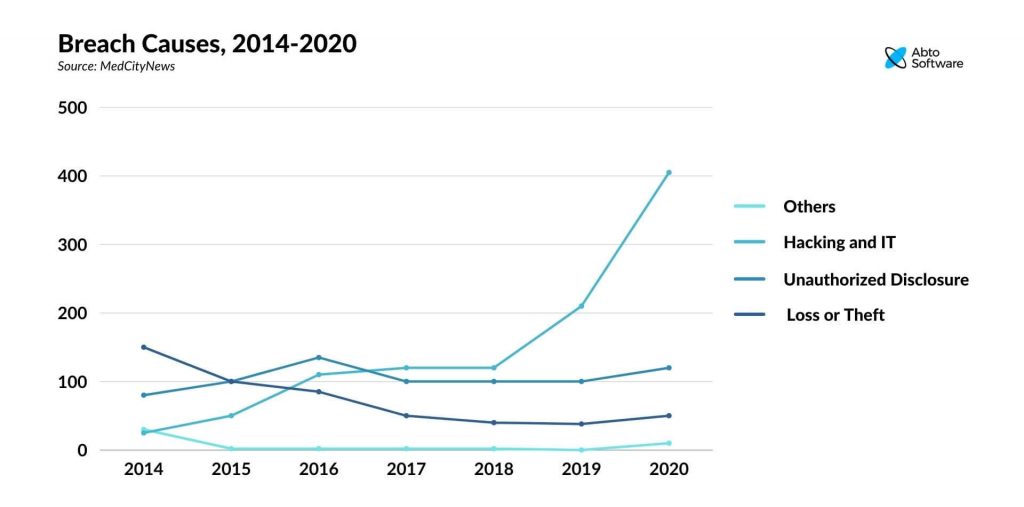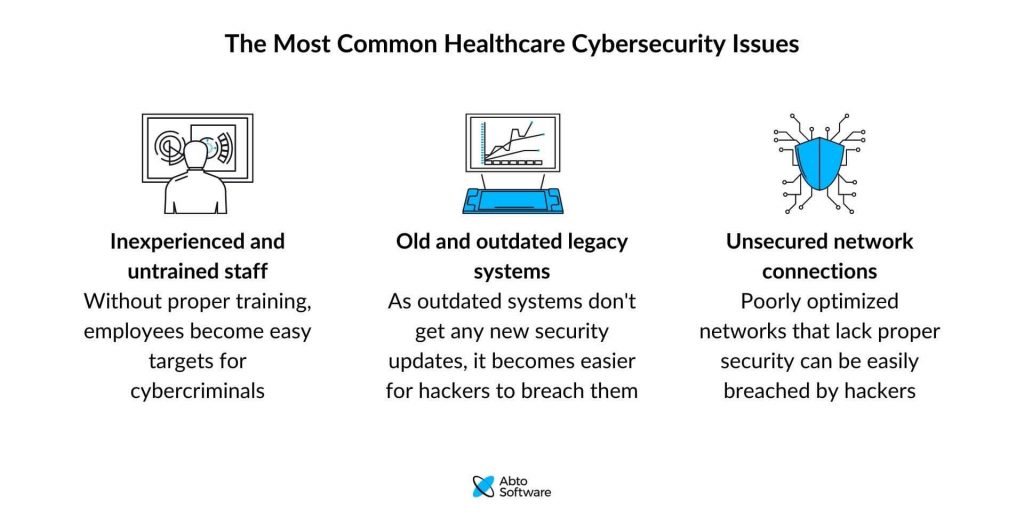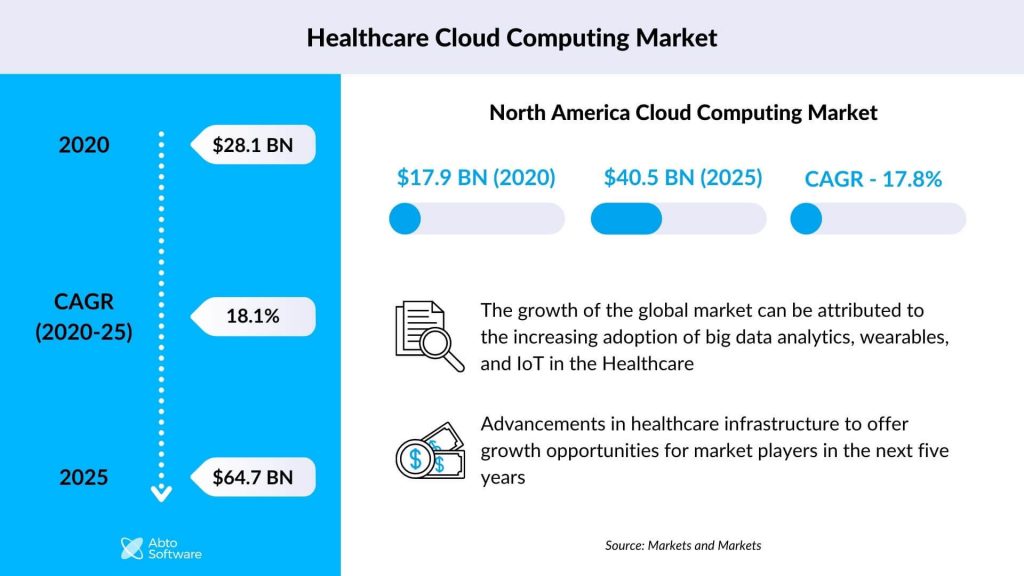Top 5 Ways to Fix the Most Common Healthcare Cybersecurity Issues

Healthcare cybersecurity has seen a 55% increase in threats over the last several years. Along with finance, it is the most targeted industry by cybercriminals. Indeed, Verizon found that in 2020 the healthcare industry lost around $25 billion. Even though many fall victim to malicious attacks, there are several ways of protecting your organization. Let’s take a look at the most common types of healthcare cyber attacks and the ways to battle them.
Importance of data protection in healthcare
First things first, why is the healthcare industry so prone to cybersecurity threats? The answer lays in the type and the amount of data that healthcare companies collect.
All patients provide their personal information to health organizations. That can be anything from the date of birth to social security numbers and payment information. Losing such information to a cybercriminal leads to identity theft, financial losses, and other harmful effects.
Healthcare companies can also feel the effects of such data breaches themselves. They often lead to law proceedings and compensations that have to be paid to the affected patients. That can have a great financial impact on the organization and even lead to its complete closure.

The most common healthcare cybersecurity issues
Let’s now take a look at the most common factors that cause healthcare cybersecurity issues.
Old and outdated legacy systems
One of the most common ways to fall victim to a hacking attack is using old or outdated systems. As technologies become more advanced, so do the abilities of cybercriminals. Older technologies usually no longer receive the proper support. Also, updates and are unable to compete with the newer ones. Breaching systems that use such technologies is a piece of cake for a modern hacker. Thus, more advanced systems will help bring long-lasting security to your data.
Inexperienced and untrained staff
Ignorance is the root of all evil, as they say, and it cannot be more true when it comes to data security. Without proper training, your employees become easy targets for cybercriminals.
Unsecured network connections
All organizations use wireless networks to keep their processes up and running. Yet, many do not realize that cybercriminals can also use this network as a way in for a potential attack. Poorly optimized networks that lack proper security can be easily breached by hackers.

Main types of healthcare cyber attacks
Knowing what type of healthcare cyber attack to expect can help to implement a proper data security strategy. Let’s take a look at the three most common ones.
Malware/ransomware
Malware is the most popular type of cyber threat. It reaches over 70% of attacks, according to Purplesec. It involves clicking on a link or opening an email with a malicious application that immediately infects your network. There are many ways how a piece of malware can be harmful. For example, from stealing sensitive information to denying access to files and data.
Distributed denial-of-service attacks (DDoS)
DDoS attacks halt networks by overflowing them with massive amounts of internet traffic. Such attacks are especially harmful to healthcare organizations. They complicate access to medical records, set appointments, and provide high-quality patient care.
Phishing attacks
Phishing attacks are extremely harmful to healthcare organizations. They are a form of social engineering that tricks employees into revealing sensitive information. Cybercriminals send emails that entice employees to click a particular link, for example, a request to reset a password. That link will instead provide the hacker with a way into your network.
The most dangerous part about phishing attacks is that they often lead to the violation of HIPAA compliance. That, in turn, can lead to lawsuits from patients whose information was exposed. With an almost 50% success rate, according to Duo Security, phishing attacks are a real threat to healthcare organizations.
Top 5 ways to fix healthcare cybersecurity issues
There are several ways to protect your health organization from malicious attacks. Let’s take a look.
1. Opting for a telemedicine solution
Telemedicine solutions are becoming increasingly popular among health organizations. They streamline the information flow within your organization and make sure that your data stays protected.
Moreover, they bring about a wide range of additional benefits. These include smooth appointment settings, easier access to medical records, quicker payment options, and better-quality patient care.


How to Build a Telemedicine System
Development challenges, solution structure, system integrations, telemedicine app
2. Migrating to the cloud
More and more healthcare organizations are choosing to migrate their infrastructure to the cloud. In fact, the healthcare cloud computing industry has reached $28.1B in 2020 and is expected to grow to an impressive $64.7B by 2025.

That is due to the many ways data can be protected when stored in the cloud, from data encryption to blockchain usage.
Moreover, cloud services offer other benefits as well. These include reduced expenses, more flexibility, and almost limitless storage space for data.
Building a Leading Dental Practice Management Software
Features and additional tools, third-party integrations, optional web applications, benefits of cloud-based software
3. Using multi-factor authentication
Proper implementation and use of multi-factor authentication across your organization can reduce the number of automated attacks by as much as 99.9%, according to Google. It is a great way of protection from neglect of cyber security policies that will inevitably happen among your employees.
4. Conducting regular employee security training and testing
As mentioned before, data breaches often occur because of simple ignorance. It is highly recommended to conduct regular cyber security training for all employees. That will help you make sure that everyone follows the established cyber security rules and policies. Moreover, it will also keep your staff up to date on the latest data security trends.
Besides, you have to put special attention to bringing new employees up to speed on your organization’s cyber security policies. Being unfamiliar with your data security strategy raises the risk of causing a data breach.
5. Backing up data and setting recovery plans
Backup in a separate location is a good way to protect your organization. Especially in the case of a malicious attack that steals or prevents you from accessing data. Make sure all essential data is backed up daily, either on a separate on-premise server or in the cloud.
Furthermore, it is always a good idea to have an action plan in case a cyberattack occurs. That will help you respond to the attack quicker and make its effects less significant.
Improve your healthcare cybersecurity with Abto Software
You cannot overstate the importance of data security in healthcare. Proper tools are required to protect your organization and prevent cybercriminals from stealing your data.
Abto Software has extensive experience in implementing solid healthcare cybersecurity strategies for many clients. Reach out if you require a strong tech partner that can help you protect your organization.


